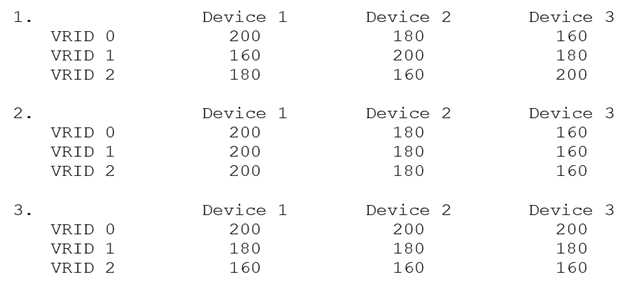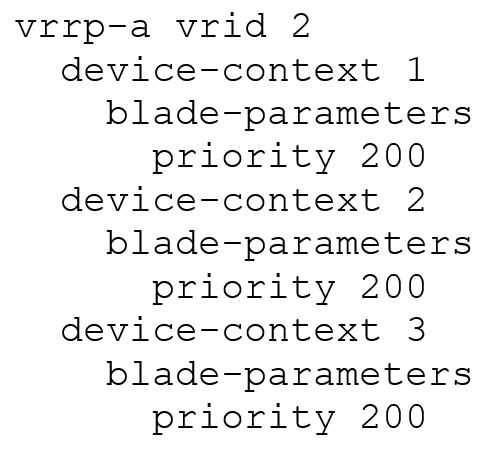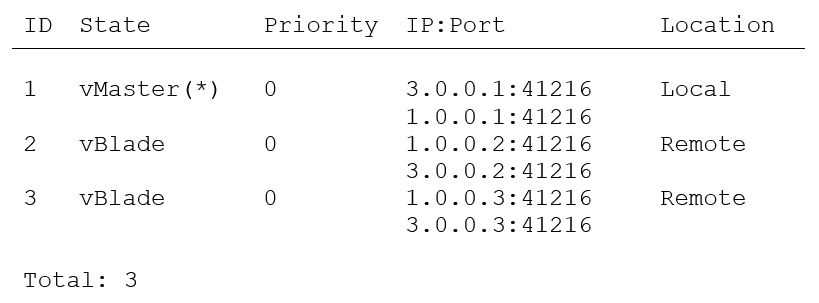a10 networks a10 system administration practice test
A10 Certified Professional System Administration 4
Question 1
When you execute a reboot command on the vMaster, how is aVCS Chassis affected?
- A. Reboot is performed on vMaster and reload operation on vBlades.
- B. All devices in the chassis are rebooted.
- C. Reboot is performed on vMaster.
- D. Reboot is performed only on vBlades.
Answer:
A
Question 2
What information is typically submitted with every aXAPI call after the initial login is complete?
- A. Authorization header with signature
- B. The ACOS device serial number
- C. The programming language being used
- D. The AXAPI special permission XML file
- E. Log file location
Answer:
A
Question 3
What is the purpose of a VRRP-A floating-IP address?
- A. To serve as a tie-breaker when selecting a VRRP-A owner.
- B. To provide a single next hop IP address for uplink and downlink devices.
- C. To use as source IP address for VRRP-A hellos.
- D. To provide a single IP to manage all VRRP-A devices in the set.
Answer:
B
Question 4
When vBlade A issues a “vcs vmaster-take-over 200” command, which statement is true?
- A. The command is ignored when the current vMaster is in vMaster maintenance mode.
- B. Any subsequent vmaster-take-over command within the chassis with a parameter smaller than 201 is ignored.
- C. The 200 priority is compared to the current vmaster’s default vrid priority to determine which device controls the chassis.
- D. If an administrator on vBlade B were to simultaneously issue command vcs vmaster-take-over 210, vBlade B would become the vMaster.
Answer:
C
Question 5
Which statement describes the effect this command:
erase preserve-management
- A. The startup-config file is erased and the ACOS is immediately rebooted
- B. All configuration profiles, SSL certificates, aFlex polices, black/white lists, and system logs are erased the next time the system reboots
- C. The startup-config file is erased but the management interface ip configuration is kept
- D. The start-up config file is erased but the all of the admin accounts are preserved
Answer:
C
Question 6
Which VRID priority scheme will implement an Active-Active-Active VRRP-A deployment with three
ACOS devices?
- A. 1
- B. 2
- C. 3
Answer:
A
Question 7
Select two aXAPI implementation use cases. (Choose two.)
- A. Auto-syncing the configurations via virtual chassis.
- B. Extract ACOS configurations or statistics from ACOS.
- C. Perform deep packet inspection on traffic and redirect and modify content.
- D. Writing scripts to automate configuration changes.
Answer:
B, D
Question 8
ACOS can log the following accounting records for administrative sessions:
- A. device access attempts only
- B. syslog errors of a specified severity level
- C. device access and command entry attempts
- D. command entry attempts only
- E. syslog errors of severity greater than a specified level
Answer:
C
Question 9
Given the following VRID 2 configuration, which device will host the VRID after the three devices at
the same time?
- A. Device 2
- B. Device 1
- C. VCS will randomly assign the VRID to a device based on the uptime of the device.
- D. Device 3
- E. The VRID will be hosted on all three devices at the same time.
Answer:
B
Question 10
When VRRP-A is enabled on a device with multiple partitions, which statement about VRID 0 is
correct?
- A. Each partition has its own distinct VRID 0.
- B. VRID 0 only exists in the shared partition; private partitions can only contain VRIDs numbered higher than 0.
- C. VRID 0 is initially enabled only in the shared partition; partition administrators can enable VRID 0 in their partitions.
- D. When using VRRP-A on a device with multiple partitions, VRID 0 is automatically disabled.
Answer:
A
Question 11
You upgraded the boot image and changed the boot pointer to the new image using bootimage
command. Which of the following operations will load the new image?
- A. reload
- B. restore
- C. system-reset
- D. shutdown –r
- E. restart
- F. reboot
Answer:
F
Question 12
Device 1 is the vMaster in a virtual chassis. Select the command set that adds an IP address to VE
interface 200 on device 3?
- A. interface ve 200 device 3 ip address 198.162.4.1 /24
- B. interface device-context 3 interface ve 200 ip address 198.162.4.1 /24
- C. interface ve 3/200 ip address 198.162.4.1 /24
- D. vcs device-context device 3 interface ve 200 ip address 198.162.4.1 /24
Answer:
C
Question 13
Given the following configuration, which statement describes Alice’s partition access rights?
- A. Alice can access the partitions alpha and beta partition, but not the shared partition.
- B. Alice can access the partitions alpha, beta, as well as the shared partition.
- C. Alice can access either the alpha or beta partitions, but cannot access them both.
- D. Alice can access the shared partition provided she is not currently accessing the alpha or beta partition.
Answer:
A
Question 14
In the following configuration:
Where network 3.0.0.x on each device is on a VE interface dedicated to aVCS traffic, what must you
do to ensure that command “device-context x” always succeeds?
- A. Verify the interface is untagged on each device.
- B. Enable management service ssh on that interface for each device.
- C. Configure vcs floating-ip on network 3.0.0.0 /24.
- D. Apply acl ”permit 3.0.0.0 /24” on that interface for each device.
Answer:
C
Question 15
Which statement correctly describes the following configuration?
snmp enable traps slb-change server
snmp enable traps slb-change server-port
snmp enable traps slb-change vip
snmp enable traps slb-change vip-port
- A. These commands enable SNMP traps for any SLB changes
- B. These commands enable SNMP traps for only SLB changes related to virtual-server
- C. These commands only enable SNMP traps for the creation or removal of virtual and real servers and ports
- D. These commands enable SNMP traps for only SLB changes related to real-servers
Answer:
C